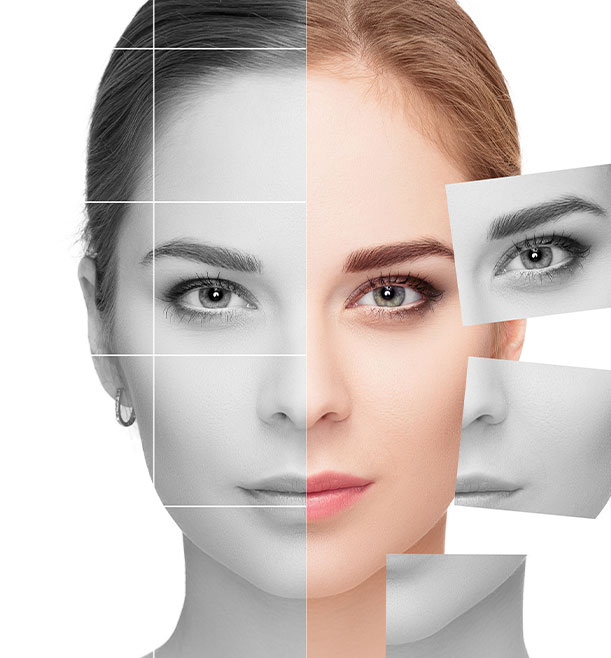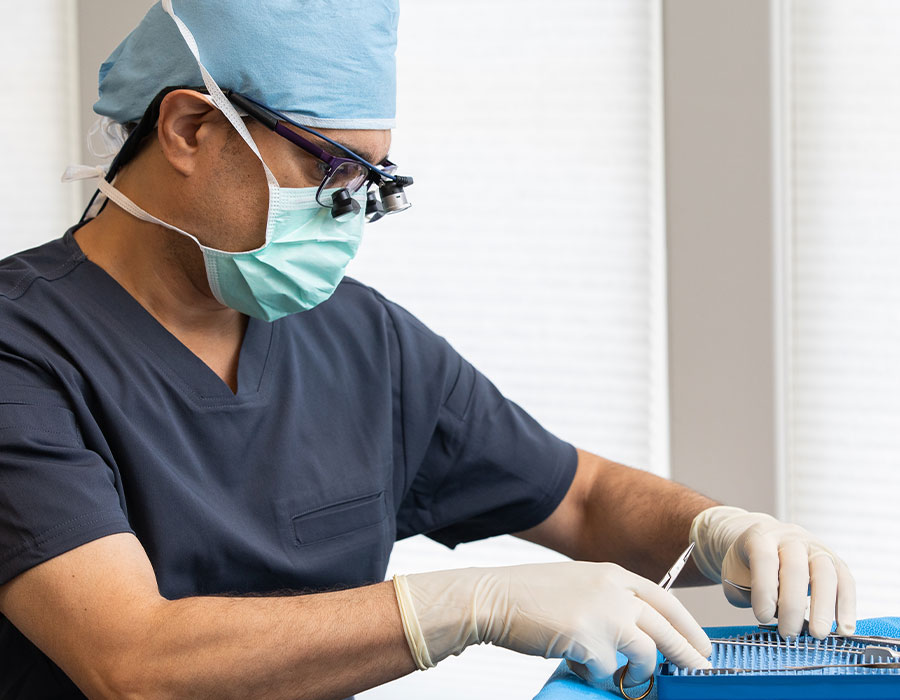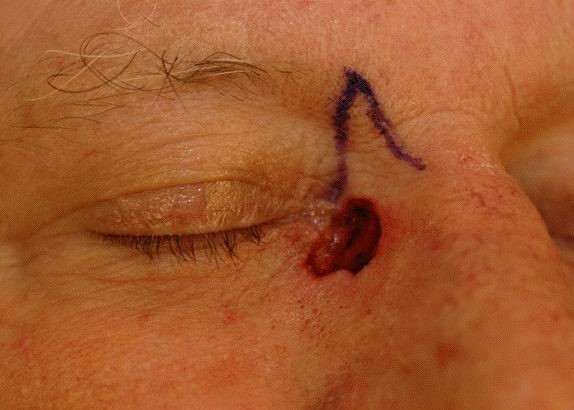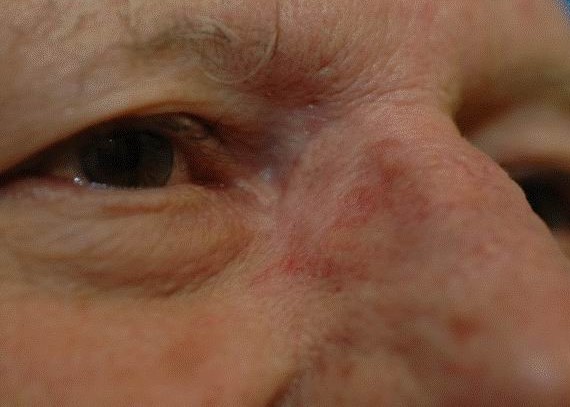Reconstructive Surgery
Oculofacial reconstructive surgery often needed due to trauma, cancer, or birth circumstances, beyond one's control.

Oculofacial reconstructive surgery often needed due to trauma, cancer, or birth circumstances, beyond one's control.


Our team has extensive experience in treating patients who need reconstructive procedures for eyelid malpositions, facial skin cancer, orbital/facial trauma, lacrimal (tearing) problems, Thyroid Eye Disease, and scarring. The situation surrounding a reconstructive procedure can be challenging, and we accompany you through the process to ensure that your needs are met, and that you achieve the best outcome possible. Undergoing a oculofacial reconstructive procedure is often not a choice, but it can be a successful experience.
The eyelid skin is the thinnest and most sensitive skin on your body.
As a result, this is often the first area on your face to show change from sun damage and aging. Unfortunately, sun damage and other environmental toxins not only cause the skin to age but can cause serious damage. Skin cancer of the eyelids is relatively common and several types exist. The presence of a nodule or lesion on the eyelid that grows, bleed or ulcerates should be evaluated. This involves examination and sometimes a biopsy.
Basal cell tumors represent the ninety percent of eyelid tumors. These skin cancers grow slowly over months and years. They most often appear as a pearly nodule that eventually starts to break down and ulcerate. Despite being a cancer, these tumors don’t spread to distant areas but rather just continue to grow and infiltrate the surrounding tissue. They typically can be cured by simple excision followed by reconstruction of the defect left behind after the tumor removal.
These types of tumors occur much less common but are more aggressive and require more involved care to ensure complete treatment. Again, primary treatment involves removing the tumor, but care must also be taken to ensure the tumor has not spread anywhere, causing larger health problems. Your surgeon will help coordinate this as part of your treatment depending on the size and circumstances of the tumor at presentation.
Skin cancer needs to be removed surgically by a skilled individual who can not only remove the tumor but reconstruct the eyelid or area where the tumor was removed. Sometimes surgeon will do this themselves at a surgical facility with an on site pathologist who can immediately examine the specimen to ensure the whole tumor was removed. Other times, the help of a dermatologic surgeon specializing in Mohs surgical excision will be utilized. This procedure is completed into two steps, the first in the dermatologist’s office with immediate examination of the tumor to ensure its complete removal followed by the reconstructive surgery by your surgeon.
Eyelid reconstruction may be undertaken in a variety of situations. Defects in the eyelid may arise form a variety of situations, but most commonly after trauma or tumor excision. Simple superficial defects in the eyelid may occur after minor trauma or removal of small growths. Many of these require nothing more than local wound care and will heal on their own in a week to 10 days. Some simple superficial defects may require a few sutures with the same local wound care.
In some instances, such as after traumatic injuries or removal of larger growths or skin cancers, larger defects may extend through the entire lid. Many of these can be sutured together directly, but many others may require more complex reconstructions. In many of these more complex cases, the surgeon will need to use transfer of adjacent tissues (what we call ”flaps”), or transfer of skin from other parts of the eyelid face or body (what we call “skin grafts”) to complete the reconstruction. Some of these more complex reconstructions may require more than one operation to complete (what we call “staged reconstruction”).
Thyroid eye disease is an autoimmune inflammatory disorder of uncertain etiology that affects the tissues of the orbit (i.e. eyelids, eye muscles and other soft tissues surrounding the eyes). Patients with this disorder often have an associated thyroid abnormality which may manifest either before, during or after the orbital signs and symptoms. However, a small percentage of patients may have eyelid and orbital manifestations of the disorder without developing a thyroid abnormality.
Thyroid orbitopathy can develop and affect patients with varying degrees of severity. The disease can begin suddenly and progress rapidly over days to weeks or start insidiously and progress gradually over a long period of time. The majority of patients have mild inflammation, the most common signs and symptoms of which are retraction of the upper and/or lower eyelids and bulging of the eyes (also known as proptosis). In cases of moderate inflammation, patients may also have varying degrees of double vision and eyelid swelling as well as visible redness of the lids and eyes. Other common signs and symptoms include, redness, dryness, excessive mucous and tear production, and pain/pressure behind the eyes. A small percentage of patients with thyroid eye disease develop severe inflammation with massive enlargement of the eye muscles which can result in compression of the optic nerve and, and possible, permanent vision loss. In most cases, however, the inflammatory process is self-limited and runs a course lasting 6 months to a couple years before subsiding. After the inflammatory phase of the disease subsides, scarring of eyelid and orbital tissues may result in the persistence of eyelid retraction, proptosis and double vision.
It is important to be evaluated by an ophthalmologist to assess the ophthalmic manifestations of the disease as well as by an endocrinologist to manage concurrent thyroid abnormalities. Patients with mild Thyroid Eye Disease are usually evaluated on a 3 to 4 month interval basis to monitor progression of the disease and managed with measures to reduce ocular symptoms. Patients with moderate to severe Thyroid Eye Disease may require medical or surgical intervention to reduce inflammation or improve vision. Medical treatment starts with more conservative measures of lubricating eye drops, cool compresses, and non-steroidal anti-inflammatory medicine such as Ibuprofen or Naproxen. One of the most important non-invasive, though challenging, interventions in combating disease severity is smoking cessation. Cigarette smoking has been associated with development of worsening thyroid orbitopathy and increased risk of vision loss, and the importance of therefore cessation of smoking cannot be overstated.
As disease severity intensifies, IV or oral steroids (prednisone and related medicines) may be required. There are a variety of immune modulating drugs that are now available to mitigate the inflammation, but most are still considered experimental or second line agents.
Once the inflammatory phase of the disease has subsided, surgical rehabilitation can be initiated. Patients with eyelid abnormalities, double-vision or proptosis may be eligible for surgical correction to improve their function and appearance, usually performed in a staged fashion. Orbital decompression [bone and/or fat] will first be considered to allow the eyes to settle back in the eye socket and decrease bulginess. Once that has been achieved, eye muscle surgery will be performed in patients that have bothersome double vision (diplopia). Eyelid retraction repair will then be performed to improve eyelid position to allow better eyelid closure. As the disease process will cause enlargement of the eyelid fat and skin, blepharoplasty is often performed to improve cosmesis.
Entropion is a condition in which the eyelid is rolled inward toward the eye. It can occur as a result of advancing age and weakening of certain eyelid muscles. Entropion may also occur as a result of trauma, scarring, or previous surgeries. Entropion may also occur in children.
A turned in eyelid rubs against the eye, making it red, irritated, painful, and sensitive to light and wind. If it is not treated the condition can lead to excessive tearing, mucous discharge and scratching or scarring of the cornea. A chronically turned in eyelid can result in acute sensitivity to light and may lead to eye infections, corneal abrasions, or corneal ulcers. If entropion exists, it is important to surgically repair the condition before permanent damage to the eye occurs.
There are a number of surgical techniques for successfully treating entropion, depending on the cause and presenting anatomic problem. The most common surgical treatment involves tightening of the eyelid attachment to the eye socket, while reinforcing the muscle attachments on the inside of the eyelid to restore the lid to its normal position. The surgery to repair entropion is usually performed as an outpatient procedure under local anesthesia or with IV sedation. Patients recovery quickly using an antibiotic ointment for about one week after surgery. Most patients experience immediate resolution of the problem following surgery.
In certain situations, a non-incisional entropion repair, using only sutures, may be performed as an in-office procedure under local anesthesia. This procedure, sometimes referred to as the “Quickert” procedure requires several strategically placed sutures which externally rotate the eyelid. This procedure is an excellent treatment for patients who are not suitable for surgery, or until more definitive surgery can be performed.
Ectropion is an eyelid malposition indicating the lower eyelid is “rolled out” away from the eye, or is sagging away from the eye and the wet, inner surface of the eye (conjunctiva) may be exposed and visible. Normally, the upper and lower eyelids oppose each other, lubricating and protecting the eye. If the edge of one eyelid turns outward, the two eyelids cannot meet properly and tears are not spread evenly over the eye, and the sagging lower eyelid may leave the eye exposed and dry. If the ectropion is not treated, the condition can lead to chronic tearing, eye irritation, redness, pain, a gritty feeling, crusting of the eyelid, mucous discharge, and breakdown of the cornea due to exposure.
In the United States, injuries to the eyes and eye socket are unfortunately common place. Eyelid laceration, tear drain injuries, bleeding within and bruising around the eye, and fractures of the bones of the eye socket can all occur. These injuries often occur from sporting activities like baseball, soccer or football. In addition car accidents, fist fights, and dog bites are other common causes. Trauma to the orbit and eye area most often results in bruising, eyelid lacerations, and fractures of the orbital bone Since the bones of the eye socket done move like your arm or leg, they don’t all need to be fixed. Fractures causing double vision or large fractures into the sinus should typically be repaired in a timely fashion. Sometimes this is not possible but late repairs, despite being more difficult, can still be done.
Sometimes trauma is severe enough to irreparably injure the eye. Along with diseased eyes that are blind, painful and disfiguring, the removal of an eye (enucleation) is indicated when the eye can not be salvaged. Reconstruction of the eye socket, followed by fabrication of a prosthetic eye (performed by an ocularist), typically leads to a very pleasing result. Regular examinations are required as occasionally further reconstruction may be needed to retain proper fit of an eye prosthesis.
Orbital infection, or Orbital cellulitis, is an aggressive sight, and even life, threatening process. Usually arising secondarily from an adjacent sinus infection, this situation must be treated swiftly and aggressively with antibiotics and often surgery. Close follow up and monitoring is required to treat these infections, but is typically successful. Of note, not all infections occur as an extension of sinusitis. This can also occur after trauma to the eyelid, eye or orbit as well as in patients whose immune system is challenged.
In both children and adults, a variety of tumors can occur in the eye socket. Some grow slowly, and go unnoticed while others can grow rapidly; impairing vision and causing even greater problems. CT scans and MRI’s are the best method for detecting and differentiating these lesions prior to having surgery. Once the location is identified, along with the general characteristics of the lesion, a treatment plan can be created. In some instances your orbital surgeon can treat these tumors on their own, often as an outpatient. On the other hand, aggressive tumors may require the help of other surgical specialist and in patient hospital treatment.
The tear film on the surface of the eye is a critical component of maintaining vision. Tears nourish and lubricate the surface of the eye as well as wash away debris. A smooth, balanced tear film (consisting of water, oil and mucus) also allows light to enter the eye in an optimal fashion. If there is a disturbance of the tear film, patients will often experience tearing, burning, irritation and most importantly blurred vision, which often fluctuates. Patients who experience tearing either have a problem with ocular surface lubrication and tear production, or tear drainage.
The eye has two sets of structures that produce tears. Smaller tear glands help maintain a baseline level of moisture on the surface of the eye. Unfortunately, inflammatory conditions like rheumatoid arthritis, Sjogrens disease as well as aging and menopause lead to decreased tear production. As tear production diminishes, the surface of the eye starts to dry out. Further, inflammation of the oil glands along the edge of the eyelid, common in patients with roseacea, also causes early breakdown and evaporation of the tear film. The brain senses the eye is both dry and irritated and in turn signals the main tear gland to flush the eye. As a result, the dry eye paradoxically tears and becomes watery. Patients with dry eyes note intermittent tearing of the eyes during activities like reading, driving, watching TV, using a computer or going outside on a windy day. These all cause the eye to dry out because the eye blinks less during these activities. The treatment for dry eyes includes 1) replacing tears with artificial lubricants which can be bought over the counter, 2) medications like Restasis that decrease inflammation in tear glands and encourages natural tear production to resume and finally 3) plugging of the tear drain. Other causes of increased tear production exist like allergies, infections and eyelashes poking the eye. These conditions can often be found during examination.

Team
Focusing on a natural and age-appropriate look, Dr. Amadi will deliver the finest personalized care, giving you the results you desire.
Meet Dr. AmadiBefore & After
Undergoing a oculofacial reconstructive procedure is often not a choice, but it can be a successful experience.
View the gallery


Dr. Amadi is an ASOPRS trained surgeon and member, and is a Board certified Oculoplastics surgeon who is not only well trained and experienced in eyelid reconstruction, but are also trained and experienced in the function of the eyelids as the primary protection of the eyeball. Dr Amadi is well versed in the intricacies of the eyelid anatomy and the pitfalls associated with reconstructing this area. Not only does he perform the most complex eyelid reconstructions at his private office and Harborview Medical Center, he is also the Co-Director of the University of Washington Oculofacial Plastic and Orbital Surgery Fellowship at Harborview Center, and is responsible for training/teaching medical students, residents and fellows in the anatomy and surgery of this region.
Orbital decompression, eye muscle surgery (strabismus surgery), and eyelid retraction surgery will usually be covered by insurance as they are performed to improve the patient’s eye and eyelid function.
Upper and lower “eyelid lifts”, medically referred to as blepharoplasty, are NOT covered. Insurance companies consider blepharoplasty as an aesthetic surgery, even though orbital, eyelid and brow fat enlargement occur as a result of the disease process. This is a source of frustration for both patients and surgeons.
When choosing a surgeon to treat your Thyroid Eye Disease, you should select a surgeon who specializes in diseases of the Orbit , with extensive experience in eyelid and eye socket surgery. Dr Amadi’s membership in the American Society of Ophthalmic Plastic and Reconstructive Surgery (ASOPRS) indicates he is a board certified ophthalmologist who knows the anatomy and structure of the eyelids and orbit, with extensive training in Oculofacial plastic reconstructive and cosmetic surgery.
Dr. Amadi’s practice has been dedicated to this field since 2001. Furthermore, he has trained dozens of other surgeons [residents and fellows] in this area of surgery as Co-Director of the Oculofacial Plastic and Reconstructive Surgery Service and Fellowship at the University of Washington Medical Center and Harborview Medical Center.
When choosing a surgeon to perform entropion surgery or ectropion repair, look for a cosmetic and reconstructive facial surgeon who specializes in the eyelids, orbit, and tear drain system. Dr. Amadi’s membership in the American Society of Ophthalmic Plastic and Reconstructive Surgery (ASOPRS) indicates he is not only a board-certified ophthalmologist who knows the anatomy and structure of the eyelids and orbit, but also has had extensive training in ophthalmic plastic reconstructive and cosmetic surgery.
Generally the condition is the result of tissue laxity associated with aging, although it may also occur as a result of facial nerve paralysis (due to Bell’s palsy,stroke or other nurologic conditions), trauma, scarring, previous surgeries or skin cancer.
Yes, ectropion can be repaired surgically. Most patients experience immediate resolution after surgery with improvement of the symptoms, while experiencing minimal post-operative discomfort. Initially the eyelid may feel tight and slightly unnatural. But after your eyelid heals, your eye will feel comfortable and be protected from corneal scarring, infection, and loss of vision.
The orbit is a small, compact and complex structure. Oculo-Facial surgeons have undertaken the extra training to deal with the nuances of treating orbital disease and injuries. When choosing a surgeon to evaluate and treat your orbital problem, look for an Ophthalmic Facial plastic & reconstructive surgeon who specializes in the eyelid, orbit, and tear drain surgery. Dr. Amadi is a member of the American Society of Ophthalmic Plastic and Reconstructive Surgery (ASOPRS) and has extensive training required to care for these problems in children and adults. Membership in ASOPRS indicates your surgeon is not only a board certified ophthalmologist who knows the anatomy and structure of the eye and orbit, but also has expertise in ophthalmic plastic reconstructive Surgery to appropriately care for your problem.
An obstruction of the tear ducts may occur due to numerous reasons (aging, trauma, inflammatory conditions, medications and tumors) and cause numerous signs and symptoms ranging from wateriness or tearing to discharge, swelling, pain and infection. These signs and symptoms may result from the tear drainage system becoming obstructed at any point from the puncta to the nasal cavity.
If the tear passageways become blocked, tears cannot drain properly and may overflow from the eyelids onto the face as if you were crying. In addition to excessive tearing you may also experience blurred vision, mucous discharge, eye irritation, and painful swelling in the inner corner of the eyelids. A thorough examination by an ophthalmic plastic surgeon can determine the cause of tearing and recommended treatment.
Depending on your symptoms and their severity, your specialist will suggest an appropriate course. In mild cases, a treatment of warm compresses and antibiotics may be recommended. In more severe cases, surgical intervention to bypass the tear duct obstruction (dacryocystorhinostomy or DCR surgery) may be recommended. A DCR is performed by creating a new tear passageway from the lacrimal sac to the nose, bypassing the obstruction. A small silicone tube called a stent may temporarily be placed in the new passageway to keep it open during the healing process. In a small percentage of cases, the obstruction is between the puncta and the lacrimal sac. In these cases, in addition to the DCR procedure, the surgeon will insert a tiny artificial tear drain called a Jones Tube. A Jones Tube is made of Pyrex glass and allows tears to drain directly from the eye to the lacrimal sac.
DCR surgery is usually performed as an outpatient procedure. Patients usually have some bruising and swelling on the side of the nose that subsides in one to two weeks. In general, surgery has a greater than 90% success rate and most patients experience a resolution of their tearing and discharge problems once surgery and recovery are completed.
When choosing a surgeon to perform a dacryocystorhinostomy or DCR, look for an ophthalmic plastic reconstructive and cosmetic surgeon who specializes in the eyelids, orbit, and tear drain system. It’s also important that he or she is a member of the American Society of Ophthalmic Plastic and Reconstructive Surgery (ASOPRS). This indicates your surgeon is not only a board-certified ophthalmologist who knows the anatomy and structure of the eyelids and orbit, but also has had extensive training in ophthalmic plastic reconstructive and cosmetic surgery.